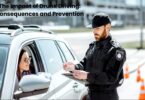The post is developed in partnership with BetterHelp.
No one ever wants to experience a panic attack. It’s a very unpleasant, scary experience that can make you feel like you’re in danger of harming yourself or even dying. Many people who are living with anxiety disorder will experience a panic attack at some point, especially if the anxiety goes unchecked.
While having panic attacks can feel terrible, it’s even harder when they come on in public. This makes the event more public, and can feel even more overwhelming to keep under control. Loud noises, crowds, and the added stimulation can exacerbate anxious and panicked feelings.
So, what can you do when a panic attack hits in public? Let’s explain the signs and symptoms of panic attacks, and the steps you can take to control or stop them when they happen.
1. Learn to Recognize the Signs of an Oncoming Panic Attack
One of the most important things you can do is recognize the signs of an oncoming panic attack as it arises. This will allow you to get a jump on managing what happens next, or even nip it in the bud.
A panic attack is a combination of physical symptoms and emotional symptoms. If a panic attack is coming, you will likely experience some of these symptoms:
- Sweating.
- Trembling or shaking.
- Hot flashes or chills.
- A pounding, fast heartbeat.
- The tightening of your chest, and shortness of breath.
- Intense feelings of fear or impending doom.
- Repetitive worried thoughts.
So if you are in a crowded room, for example, and you feel your palms start to sweat, your heart rate quickens, and your legs start shaking, a panic attack could be around the corner.
2. Try to Not Worry What People Will Think of You
It is important to come to terms with the unique struggles you are dealing with. Generalized anxiety and panic is an extremely common disorder, affecting millions in the US alone. You should not be ashamed of experiencing these physical and emotional symptoms in public.
Try to accept that if you are in a public place and a panic attack hits, some people will probably notice something is going on. The harder you attempt to hide it from others, the more anxious you will get, which will not help you move though the panic attack.
3. Remove Yourself from the Crowd
As soon as you feel the symptoms of a panic attack coming on, you should attempt to remove yourself from any crowds as much and as soon as possible. Crowds, voices, movement, and sensations can add to the overstimulation and anxiety.
Look for a more peaceful, serene spot to make your way to nearby. If there is a quiet bench, a private bathroom, or even your car close by, try to head there before you begin struggling to breath. It’s best to have peace and quiet and solitude when de-escalating the attack.
4. Tell Someone You Know That It’s Happening
Are you with a friend or loved one when the panic attack starts to hit? Open up to them about what you are experiencing. Let them know you will need to remove yourself from the situation. Are you in class? Have them take notes for you while you step out. Are you at a restaurant? Ask them to order for you.
Trusted individuals who are caring and patient should support you and accommodate you during this tough time. They may even assist in distracting or calming you down.
5. Focus On Getting Your Breathing Under Control
One of the scariest symptoms of panic attacks is the feeling that you can’t breathe. Panic attacks can cause your chest to tighten and your throat to constrict, making your breathing erratic and rapid. The best thing you can do for yourself during the onset of a panic attack is to focus on your breathing, and attempt to create stability.
There are many breathing techniques that can do this for you. You can inhale slowly for 7 seconds, hold for 3 seconds, then exhale slowly for 7 seconds. The timed counting can help you create a rhythm. Make sure you pick the breathing technique that works best for you. Practice it when you’re feeling totally fine, so that it comes more automatically if the time comes to use it.
6. Seek Therapy to Learn Anxiety Management
If you want to get to the root of your mental health issues, and not just treat the symptoms as they come, consider seeking professional help. Panic attacks can stem from more serious disorders like panic disorder or a variety of anxiety disorders. You don’t have to figure it all out alone – there are licensed therapists who can help you create anxiety management strategies and treat the core of your anxiety. The hope is that you won’t experience panic attacks any longer. If you’d like to learn more about panic attacks, read some of the articles available here.
7. Distract Yourself with Other Things
Staying distracted when a panic attack comes on or is in full force is a great tactic to get it under control. The key in staying distracted is to stop dwelling on the foreboding, doomful thoughts and fears running through your head. There are many ways you can stay distracted when in public:
- Go for a long walk.
- Observe the things around you. You can even play I-Spy with yourself! Look for all the red shirts in the room, or count clouds, or search for eyeglasses.
- Repeat a mantra to yourself or the lyrics of a poem or song you’ve memorized. Focusing on the words of a mantra or song can slow the pace of your wild, racing thoughts.
Photo by RODNAE Productions








